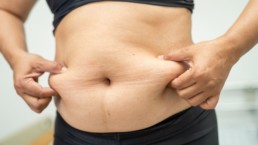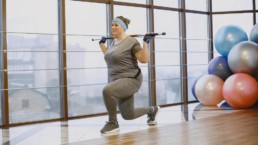Botox: The Fix for All Facial Wrinkles?

No matter how much you moisturize, how often you use sunscreen, or how many glasses of water you drink each day, wrinkles will form on your skin at some point. While many options are available to help reduce the appearance of wrinkles, Botox is one of the most popular. North America is the leading market for botox, with a share of about 63%.
The best age to start getting Botox is in your early 30s, as this is when wrinkles start to form.
Read more: At What Age Should I Start Getting Botox?
Botox is a neurotoxin that temporarily relaxes the muscles in your face, resulting in smoother skin. After trials, the FDA approved Botox for the treatment of crow’s feet, forehead wrinkles, and frown lines.
Wrinkles are caused by multiple factors, including sun damage, smoking, poor diet, and dehydration. So, does Botox get rid of wrinkles? Read on to find out.
What Are the Two Types of Wrinkles?
There are two types of wrinkles: dynamic and static.
1) Dynamic Wrinkles
The muscles in your face are responsible for your expressions – smiling, squinting, and frowning.
Over time, as the skin ages and loses elasticity, these expressions cause wrinkles.
Botox works by relaxing the muscles in your face, which smooths out the wrinkles caused by muscle movement. Botulinum toxin is used to treat dynamic wrinkles, including Botox, Dysport, and Xeomin.
2) Static Wrinkles
With age, skin loses its elasticity and the ability to snap back into place after moving or stretching. It can cause what are called static wrinkles — lines that are visible even when your face is at rest. For example, you may have crow’s feet at the outer corners of your eyes or deep furrows on your forehead.
Botox injections can reduce the appearance of static wrinkles but cannot altogether remove them. It is because static wrinkles are caused by a combination of muscle movement and sun damage, as well as the natural aging process.
Skin aging is a natural, biological occurrence that is controlled by many different factors, both internal and external.
External factors include ultraviolet (UV) radiation from the sun, which is the leading cause of skin aging. UV radiation damages the DNA in skin cells, causing their structure and function to change. It also breaks down elastin, a protein that gives skin its elasticity.
Static wrinkles are also caused by the natural aging process, which includes a decrease in collagen and elastin production. Collagen is a protein that helps keep skin firm and elastic. Elastin allows the skin to stretch and return to its original shape.
Hence, a combination of fillers and Botox may be needed to eliminate static wrinkles. Fillers are directly injected into your skin to replace lost volume, while Botox relaxes the muscles that cause wrinkles.
If you’re considering Botox in Tijuana, consulting with a board-certified center like Hospital BC is essential. Our team of experts can help you determine if Botox is the proper treatment for your specific needs. Contact us today to schedule a consultation.
Foods to Avoid After Your Gastric Bypass: What You Need to Know

The American Society for Metabolic and Bariatric Surgery (ASMBS) states that bariatric surgeries can reduce the risk of death by 30-50 percent in obese people. One of these procedures is gastric bypass surgery, which can help people lose weight by rerouting the digestive system.
During the surgery, the stomach is divided into a small upper pouch and a larger lower section. The small intestine is then attached to the upper pouch, bypassing the lower stomach and part of the small intestine. It allows food to bypass most of the stomach and upper intestine, which absorb calories and nutrients.
The recovery time after gastric bypass surgery is typically two to four weeks. During this time, it’s essential to follow a strict diet to heal correctly and avoid complications.
Read more: Bariatric Surgery Recovery Time: Back to Work After Bariatric Surgery.
Here are some foods to avoid post-surgery.
1) Sugary Drinks
Sugary drinks like soda, juice, and sports drinks can cause several problems for people who have had gastric bypass surgery. First, they can cause dumping syndrome, when food and liquids “dump” into the small intestine too quickly. It can lead to nausea, vomiting, diarrhea, and abdominal cramping. Second, sugary drinks can cause weight gain. And finally, they can worsen diabetes.
So, it’s important to avoid sugary drinks after your surgery. Instead, focus on drinking water, unsweetened tea, and other sugar-free beverages.
2) Alcohol
Alcohol contains many calories and can cause dehydration, leading to surgery complications. It is better to avoid alcohol for at least the first six months after surgery.
Additionally, alcohol can interfere with the absorption of specific vitamins and minerals, which are essential for healing and recovery.
3) Fried Foods
After a gastric bypass, it’s important to avoid fried foods. They are high in fat and calories, leading to weight gain. Fried foods can be difficult to digest, which can cause discomfort and indigestion, where food moves too quickly through the small intestine.
You may experience nausea, vomiting, diarrhea, and abdominal pain after eating fried foods like beef, French fries, potato chips, and others. Instead, opt for baked or grilled foods. These are lower in fat and calories and will be easier on your stomach.
4) Dairy Products
Dairy items like cheese, ice cream, and milk can be difficult to digest after having gastric bypass surgery. The lactose in dairy products can cause stomach pain, bloating, and diarrhea. If you eat dairy, choose lactose-free options or take a lactase supplement with your meal.
It’s also important to avoid high-fat dairy products, like whole milk, heavy cream, and butter. Such foods can increase the risk of developing obesity and diabetes.
Hospital BC is one of the best places to under a gastric bypass in Mexico. Our team of highly skilled professionals will make sure you’re comfortable and safe throughout the entire process. We will guide you through every step, from pre-op to post-op.
Expert Tips to Recover Faster After Gastric Sleeve Surgery

Obesity is a chronic disease that can lead to many other health problems, such as heart disease, stroke, and diabetes. The WHO reports that a body mass index (BMI) over 25 is considered overweight, and over 30 is obese.
One of the standard procedures to treat obesity by the American Society for Metabolic and Bariatric Surgery is gastric sleeve surgery, also called vertical sleeve gastrectomy (VSG).
Gastric sleeve surgery is a safe and effective way to help people with obesity lose weight and improve their health.
How Does the Surgery Work?
The medical procedure involves removing a large portion of the stomach, which reduces the amount of food you can eat and makes you feel full more quickly.
The surgery is usually done as a laparoscopic surgery, which means that a few small incisions are made in the abdomen, and a thin tube with a camera is inserted. The surgeon then removes the excess stomach tissue through these incisions.
Most people who have gastric sleeve surgery will lose about 60% of their excess body weight within the first year after surgery.
The recovery period after gastric sleeve surgery is generally short, and most people can return to normal activities within a few days. However, you can do some things to help ensure a smooth and speedy recovery.
1. Drink Plenty of Fluids and Eat Healthy Foods
Following gastric sleeve surgery, drinking plenty of fluids and eating healthy foods are essential. It will help your body to heal and recover more quickly.
Drink around eight glasses of water daily, and eat plenty of fruits, vegetables, and lean proteins. Avoid sugary drinks and foods high in fat and calories.
Read more: What Happens If You Eat Solid Food Right After Having a Gastric Sleeve? Nothing Positive?
2. Take It Easy and Rest As Much As Possible
It is essential to give your body the time it needs to heal after surgery. You should take it easy for the first few days and rest as much as possible. Avoid strenuous activity, such as exercising, lifting heavy objects, or sexual activity. These activities can put too much strain on your incisions and delay the healing process.
Sleep is also crucial for recovery. Getting enough sleep will help the body to heal and reduce stress levels. Sleeping improves the immune system and helps to repair tissues. It also allows the body to produce more growth hormones, which is essential for healing.
3. Breathing Exercises
One of the best things you can do for your post-operative recovery is to focus on breathing exercises. It will help prevent pain and inflammation in the chest and lungs and improve your overall circulation.
If you want to undergo a gastric sleeve in Mexico, contact Hospital BC. Our team of medical professionals will help make your surgery and recovery process as smooth as possible. Call our team to get more information on gastric sleeve surgery.
Is It Safe to Exercise After Liposuction?

Cosmetic surgeries are on the rise as people become increasingly interested in improving their appearance. One such surgery is liposuction, which can help to sculpt the body by removing unwanted fat deposits.
Understandably, patients who have undergone liposuction may be eager to return to their routine, including exercise. However, taking things slowly and not overdoing them is essential, as this could lead to complications.
How Soon Can I Exercise After Liposuction?
While it is crucial to maintain an active and healthy lifestyle to achieve long-lasting results from liposuction, it is vital to give your body time to recover after the procedure.
Strenuous activities like running, jogging, weight-lifting, etc., can put unnecessary strain on your body and cause discomfort.
You may experience bleeding, bruising, infection, and swelling after liposuction.
It is best to wait for at least four-six weeks before resuming any rigorous and strenuous exercise. Toning exercises and light cardio can be started two weeks post-surgery.
It is essential to listen to your body and not push yourself too hard too soon. Some factors that affect the results and recovery from lipo are:
- The type of procedure you undergo
- The areas treated
- Your age
- Your skin tone
- Your lifestyle
- Your body type
Read more: Is there an age limit on liposuction?
What Kind of Exercises Can I Do to Maintain the Results?
After liposuction, you will want to maintain your results with a healthy lifestyle. It includes eating a balanced diet and exercising regularly. But what kind of exercises can you do after abdominal liposuction?
1. After Two -Three Weeks: Light Cardio Exercises Such As Walking Or Swimming
You can start with light cardio exercises such as walking or swimming within the first week after your surgery. These activities will help increase your circulation and reduce swelling.
2. After Three-Four Weeks: Strength-Training Exercises
Gradually, you can start to add strength-training exercises to your routine. These exercises will help tone your muscles and give you a more sculpted look. These include squats, lunges, and crunches.
Start with two to three sets of 12 to 15 repetitions and increase the weight as you get stronger.
3. After Six Weeks: More Challenging Cardio Exercises
After six weeks, the incisions and swelling should be healed, and you can start to add more challenging cardio exercises to your routine. These include running, biking, aerobics, and lifting weights.
You should always consult your surgeon before starting any exercise after liposuction. They will be able to give you specific instructions based on your case.
Hospital BC offers the best liposuction in Tijuana. Our surgeons are highly skilled and experienced in performing this procedure. You can trust us to give you the best possible results.

